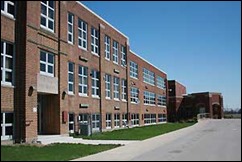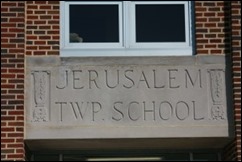Who really was paying attention in school way back when?
Posted By RichC on July 29, 2016
It has been a while since I’ve seen one of these, but once I figured out what it was, the memory of Jerusalem Elementary School and Mrs. Fell came rushing back. I still remember her taped up wooden paddle as it slammed intimidatingly on the the desks at the front of the class in order to silence the rowdy students. There was a good reason not to be sitting in that the first desk, but her actions sure did get our attention — Oh … “the good ol’ days.”
as it slammed intimidatingly on the the desks at the front of the class in order to silence the rowdy students. There was a good reason not to be sitting in that the first desk, but her actions sure did get our attention — Oh … “the good ol’ days.”
 While looking for the link to my old grade school, I noticed an interesting history of Jerusalem Township … very little of it I knew, but some of the old names and towns are part of my childhood memory.
While looking for the link to my old grade school, I noticed an interesting history of Jerusalem Township … very little of it I knew, but some of the old names and towns are part of my childhood memory.
Set in the northwest portion of Ohio on the shores of Lake Erie and Maumee Bay. The township covers 34 square miles of land. This area offers some of the finest recreational facilities in a quiet agricultural setting. Visitors to the area can experience diverse coastal environments including some of the best marshes teaming with waterfowl and wildlife. Our Lake Erie area is known as the Walleye Capital of the World. Besides walleye, perch and small-mouth bass are fun to catch. If you are not a fisherman or hunter, this area provides resting and feeding places for birds traveling to their nesting or winter grounds and is great for bird watching. There are walking and biking trails for your enjoyment. Our township is a wonderful place for clean family fun.
History
Jerusalem Township, located in Northwest Ohio, is bordered at the north by Lake Erie and Maumee Bay. It is part of the Black Swamp and in early times the land was covered with valuable timber such as: oak, walnut, hickory, ash, and elm. The soil was fertile but swampy. The earliest known inhabitants were members of the Erie Indian tribe, who were annihilated by the Iroquois around 1654. In the seventeenth century there was much fur trading with the Indians, first by the French and later the English.From 1837 to 1893 (56 years), Jerusalem Township was part of Oregon Township. Dense forests and swamps covered the land with little development until 1860. Evidence of Ottawa Indian burial grounds has been found in the area. During the late 1800’s, a number of families moved into what came to be known as Jerusalem Township. They engaged mainly in fishing, hunting, and trapping. Because the narrow roads were nearly impassable due to the mud, these people often traveled by boat to Toledo with their furs.
The first settlement of any size was begun when E.B. Ward, a Detroit businessman purchased about 9,000 acres near the mouth of Crane Creek. Part of the area became a shipyard and sawmill. A large canal was built to connect these areas to Lake Erie. A blacksmith shop appeared as well as a stave mill. These industries attracted many families. The village of Shepherdsville was established, but when a request for a post office was made, the villagers were told there was another Shepherdsville in Ohio. Consequently, they decided to name the village Bunno after a resident who was a member of the Ottawa Indian Tribe. Somehow, the spelling was changed and Bono, Ohio came into being.
On March 10, 1893, a request was granted to divide the Oregon Township. The eastern part became Jerusalem Township. Three township trustees were elected. At that time there were two small villages located in the township: Shepherdsville, later renamed Bono, and Yondota, located several miles to the west of Bono. Bono is still present today, but Yondota no longer exists. The town of Curtice, located on S. North Curtice near Brown Road, resides partly in Jerusalem Township and partly in adjoining Ottawa County.
Jerusalem Township is 34 square miles in size. Because of the swampy nature of the land, drainage has always been a problem. There are drainage ditches located beside many of the roads in the area. These were dug both to drain the farmland and also to build up the roadbeds. Two creeks, Cedar and Crane, flow through the township in a northeast direction into Lake Erie.
In response to voter’s demands, the first town hall was constructed and put into use in April 1902. It was located on Jerusalem Road (Route 2). The original building was used until 1947 when a new fire house was completed on the same site, and the township hall was then located in that building. At the present time the new fire hall fronts on Route 2 and the township hall is located directly behind it.
Jerusalem Township is predominantly an agricultural area. However, in recent years, quite a number of private homes have been built in the township. Ohio’s newest and largest state park, Maumee Bay State Park, is shared jointly between Jerusalem Township and the City of Oregon. It is considered to be the most beautiful of the Ohio State Parks. Jerusalem Township today remains a quiet pastoral township with the added attraction of its location on the shore of Maumee Bay and Lake Erie, enhancing the fishing and boating businesses.
(HISTORY OF OREGON AND JERUSALEM, by Josephine Fassett, was used extensively for information.)
A Look Back in History
The following was written by a former Bono resident, Clarence Scharlow and was submitted to the Township by his son, Kenneth Sharlow. Kenneth tells us that his father was the manager of Howard Farms prior to the Great Depression and continued to farm his own small acreage in the middle of the farm for most of his life. The Journal welcomes any excerpts, photos or articles pertaining to the history of our Township and surrounding areas.Sketch of Early Bono History
Following the end of the Civil War, the Ward Family came into this neighborhood and surveyed the timber and contour of the land. Jerome Navarre, who then was 17 years old, helped clear the land where the canal was to be dredged. Bono had a few natives still living here after the Indian tribe had been moved to Wapole Island. The Bunno family and two French Canadian families lived near the Metzger Marsh on the Old Deer Trail about 1¼ mile east of Bono. A number of families, including the Tank, Sharp, Sheppard, Scharlow, McKellip, Murphy, Perry and Scheneck families, moved here when Mr. Kreger moved the Tank Sawmill from Blackberry around 1886.After the timber was cut the Dreier, Shinevar, Walter, Perry and Veler families started to farm near the village. Around 1901, Ed Stoddard came to Bono to farm onions. Mr. Stoddard had been an onion farmer on the Sciato Marsh. When his first crop was successful, a group of his old friends came to Bono. These families included the Kester, Gilmore, Schilling, Morrison, Amsler, Dennis, Cousino, Aubry, Cutcher, LaCourse, Chio, Rumery, Jeremy, Bodi, LaDuke, Cluckey, Soncrant, Ryor, Thayer, McCabe and Drewyor families. In fact, the Kesters were very instrumental in building the Bono Baptist Church. It was about this time that the Howard Farms vastly increased its onion acreage. A few years later, Henry Reno purchased a tract of ground north of Howard Farms. Mr. Reno became very successful and later branched out into Michigan.
Bono was a thriving village with a number of trades and occupations. It even had a baseball team and a half-mile racetrack where there was plenty of excitement each Sunday. Soon after the growing of onions began, a Catholic Church was built. Fishing was a thriving industry at the mouth of Ward’s Canal, Crane Creek and Cooley Canal. Each spring there was a large group of seine fisherman. Hunting and trapping was a paying occupation each winter, especially for the Navarre and Cutcher families. In the early days, most of the staves and timber were shipped out by boat by way of the canal. Captain Grant and Mr. Fioro operated sailboats for some time.
Fred Horner operated a blacksmith shop for many years. There were also two saloons in operation along with a few trade stores owned by the Aubrys, Ed Young, L. Cousino and Joe Swope. Henry Murphy became the first postmaster and the Post Office continued to operate for about 70 years. The Constable for a number of years was Frank Gifford. The first school was started shortly after the mill moved to Bono. Some of the early teachers were C. Soncrant, Carrie Roberts, Hugh Pelton, Bert Echer, and Blanch Alden. When the school became part of the centralized school district, the bus had to take the children quite some distance to attend school.
The Fraternal Order of Maccabees had a lodge at Bono and a great number of men became members. They carried insurance and their meeting place was above the Hamilton Saloon, which was called the Maccabees Building and has long since been torn down.
Now the Old Mill is gone. The onion growers are gone. All the Old Timers are gone. Even the Post Office is gone. Only the changed appearance, which shows a great amount of hard work, is the only mark left by a good, hard-working people.
If you have read this far and are too young to remember the above “high tech” device (attended grade school after about 1980), you deserve to know that the item above was used to draw the music staff with 5 evenly spaced piece of chalk on the blackboard (or likely green if you went to school after about 1970).
![]()

Comments